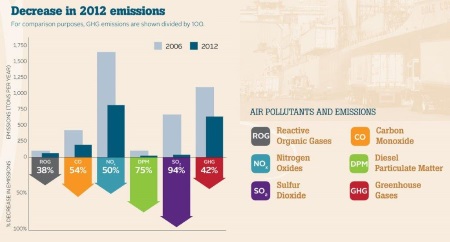
| November 18, 2014 | |
Environment: San Diego
![]() Print this Article | Send to Colleague
Print this Article | Send to Colleague

Harmful air pollutants were significantly reduced, including nitrogen oxides by
50 percent, diesel particulate matter by 75 percent, and sulfur dioxide by 94
percent.
Source/Port of San Diego
The Port of San Diego reports making significant reductions in greenhouse gas emissions and other air pollutants produced by maritime operations in San Diego Bay, achieved in part through the efforts of its Green Port program.
According to the port’s newly released 2012 Maritime Air Emissions Inventory Report, greenhouse gas emissions from non-military ocean-going vessels, harbor craft, locomotives, on-road vehicles and cargo handling equipment were reduced by 42 percent in 2012 compared to the baseline year of 2006.Additionally, other harmful air pollutants were also significantly reduced, including nitrogen oxides by 50 percent, diesel particulate matter by 75 percent, and sulfur dioxide by 94 percent.
After the baseline measurements were taken in 2006, the port put into place emissions control strategies to reduce the largest sources of emissions from its maritime operations, including a Vessel Speed Reduction Program developed in 2009, a Clean Truck Program implemented in 2010, and shore power installed at the Cruise Ship Terminal, also in 2010, to reduce emissions from berthed cruise ships.
"By reducing greenhouse gas emissions and air pollutants, we have a positive impact on climate change while also improving air quality for local communities. This environmental monitoring shows that our strategies have been effective as we strive for ‘green’ maritime operations," said Port Commission ChairmanBob Nelson. "This is good news for the residents in the neighborhoods around the port, as well as for the San Diego Bay businesses that are voluntarily working to do their part to improve air quality."
State regulations mandating engine upgrades and the use of cleaner fuels greatly contributed to the reductions of maritime emissions. Another important factor leading to decreased emissions was the recent recession, which resulted in less economic activity and fewer vessel calls. Overall, maritime activities are cleaner than they used to be. For example, ocean-going vessels produced less emissions on a per-vessel basis during 2012, compared to 2006.
The port continues to implement emission reduction strategies, such as the installation of shore power at its Tenth Avenue Marine Terminal. The shore power system began operating in early 2014, immediately reducing emissions from berthed cargo ships.
A Climate Action Plan (CAP) adopted by the port in 2013 provides a long-term strategic vision for the Green Port Program, and calls for 10 percent reductions of all greenhouse gas emissions by 2020 and 25 percent by 2035 compared to 2006 numbers. The CAP’s Transportation and Land Use category aims to reduce greenhouse gas emissions by 62,000 metric tons by 2020.
The port says it is ahead of schedule in meeting its goals. According to the report summary, the greenhouse gas reductions of 42,000 tons observed in the 2012 inventory for maritime-related activities already accounts for more than 68 percent of the Transportation and Land Use goal.
The next maritime emissions inventory will be conducted in accordance with the CAP implementation schedule in 2018 based on 2017 operations.
